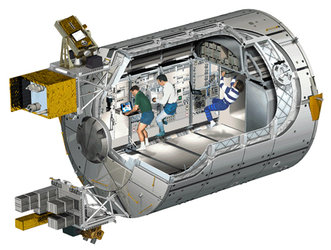ESA Columbus Essay Contest winner - Regina Peldszus
Looking over the Edge
The Value of Human Spaceflight for European Citizens
What happens to chopsticks when the parameter of gravity is changed? This is something Science Officer Don Pettit demonstrated and recorded during dinner-preparations on the International Space Station in 2003. He 'drank' tea out of a bag using the utensils. In microgravity, also liquids can reliably be picked up by chopstick; something that we did not think about or expect to be feasible on earth, even if we were on of the billions of skilled users in the world.
A tiny story about the changed potential of two simple sticks catapulted into space can make us think 'outside the box', and maybe encourage us to imagine and anticipate the potentials of other objects, ideas, or people. Imagine the possibilities of what else the dangerous, beautiful and banal idiosyncrasies of living in space show us.
From a design researcher's point of view, human spaceflight offers a vast chance to problem solve – this form of creativity, based on the ability to imagine and anticipate, is what policy makers, engineers, scientists, artists, doctors and managers need everyday to shape, sustain and enrich the lives of their fellow citizens.
For those not directly involved in space programmes – most of the nearly 490 million Europeans – the creative potential of spaceflight can encourage and inspire them to look at their own environment in a different light. Supported by space-related infrastructures, they can then go an act on what they have found, make changes and progress. They can use communications technology to observe and weave networks; transport technology to travel and trade; and health care solutions to protect others’ lives - all of which make an informed, caring and proactive citizen.
Spaceflight has been changing, and will continue to change, the way we look at our world. This doesn’t make us lose surprise over the quotidian, or make us more jaded. But it can make us more accepting, curious and open-minded. By seeing things we take for granted in a different light, we abandon set ways and prejudices. Like old explorers who try out new things, we depend on curiosity and the urge it gives us to move on, in order to re-evaluate and improve the status quo. This form of peaceful progress can only be achieved by critical, constructive and creative characters, and we need these traits in a world where the new and unfamiliar is often judged and rejected.
When there is no effort made to find out about who or what is behind the garden fence, the country border, the edge, there would be no information, no bonds, no new opportunities. If the states of Europe had not looked over their own edge with curiosity and acceptance, there would be no union today, and no joint space programme.
Pulling together across boundaries is not only a value of human spaceflight in Europe today, but was also one of the pre-requisites when the 10 founding states got together in 1975 after decades of co-operation, to merge into what ESA is today with its 17 members.
Sending real people into space who analyse and imagine, and who will relate their inspiring experience to millions of earthbound citizens, is one of the greatest chances we have today to expand our own earthbound horizons on a large scale. Not just by creating valuable new possibilities through science, technology, education and business, but by triggering thought and setting of inspirational sparks in Europeans from all walks of life.
In a modern Europe made up of 27 countries that have each looked over their own borders for more than half a century in order to pull together with the determination to ensure peace, ESA’s work in reaching out to new boundaries in co-operation with other space programmes of the world plays an integral part.
Far from being an idealistic vision, Columbus is a real manifestation of this European spirit, and a hardware example of borderless co-operation, taking its place in the largest international peaceful project, the ISS. By celebrating this vision through ESA's mission, spaceflight ensures the peaceful crossing of boundaries, in the scientific, political, economical and cultural framework of Europe. The insights of human spaceflight make citizens look over the edge. Not just the edge of our earthly atmosphere, but above all the edge in our heads.





